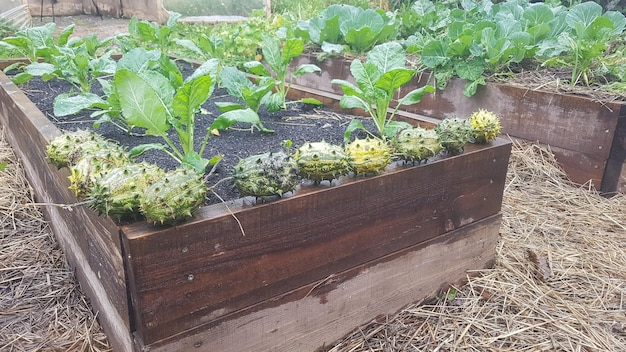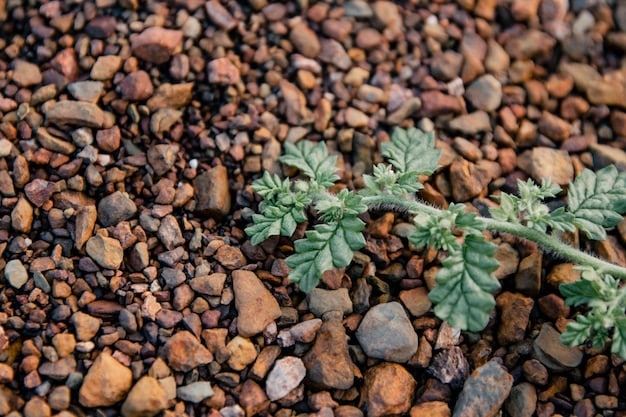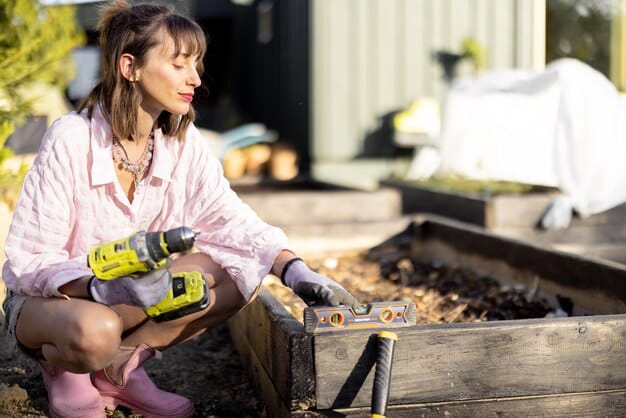Build a Raised Garden Bed: Maximize Yield and Optimize Your Garden

Building a raised garden bed allows for optimized soil conditions and drainage, leading to healthier plants and increased yields, making it a valuable project for any gardener looking to improve their growing space.
Ready to boost your harvest and transform your backyard into a thriving garden? Learn how to build a raised garden bed, optimize soil, and ensure proper drainage for maximum yields.
Why Build a Raised Garden Bed?
Raised garden beds offer numerous advantages over traditional in-ground gardening. They provide better control over soil quality, improve drainage, and can extend the growing season. Let’s explore why a raised bed might be the perfect solution for your gardening needs.
Improved Soil Control
One of the most significant benefits of raised beds is the ability to customize your soil. You can create the ideal growing medium for your plants, regardless of the existing soil conditions.
Enhanced Drainage
Raised beds naturally improve drainage, preventing waterlogging and root rot. This is especially beneficial in areas with heavy clay soil.
Here are some key reasons to consider a raised garden bed:
- Better Soil Quality: Tailor the soil mix to your plants’ specific needs.
- Improved Drainage: Prevent waterlogging and promote healthy root growth.
- Extended Growing Season: Warmer soil in spring allows for earlier planting.
- Pest and Weed Control: Easier to manage and protect your plants.
Raised beds are an excellent way to take control of your gardening environment, leading to healthier plants and better yields.

Planning Your Raised Garden Bed
Before you start building, careful planning is essential. Consider the size, location, and materials for your raised bed to ensure it meets your specific needs and complements your garden space.
Determining the Size and Shape
The size of your raised bed should be based on the available space and the type of plants you plan to grow. A standard width is 4 feet, allowing easy access from both sides.
Choosing the Right Location
Select a location that receives at least six hours of sunlight per day. Also, consider the proximity to a water source for convenient watering.
Keep these factors in mind when planning your raised bed:
- Sunlight: At least six hours of direct sunlight is crucial for most vegetables.
- Water Access: Make sure your garden bed is close to a water source.
- Accessibility: Consider how easy it will be to access and maintain the bed.
- Aesthetics: Choose materials and a design that complement your garden.
Proper planning will help you create a raised garden bed that is both functional and visually appealing.
Selecting Materials for Your Raised Bed
The materials you choose for your raised bed will impact its longevity and aesthetics. Wood is a popular choice, but other options like concrete blocks or metal can also be used. Let’s explore the pros and cons of each material.
Wood Options: Cedar vs. Untreated Lumber
Cedar is a naturally rot-resistant wood, making it a great option for raised beds. Untreated lumber is a more affordable alternative, but it may not last as long.
Alternative Materials: Concrete Blocks and Metal
Concrete blocks are durable and easy to assemble, while metal offers a modern look and can be very long-lasting.
Here’s a comparison of common materials for raised beds:
- Cedar: Naturally rot-resistant, long-lasting, but more expensive.
- Untreated Lumber: Affordable, but may require replacement sooner.
- Concrete Blocks: Durable, easy to assemble, but can be less aesthetically pleasing.
- Metal: Modern look, long-lasting, but can heat up in direct sunlight.
Ultimately, the best material for your raised bed depends on your budget, aesthetic preferences, and how long you want the bed to last.

Building Your Raised Garden Bed: A Step-by-Step Guide
Now that you’ve planned your raised bed and chosen your materials, it’s time to start building. This step-by-step guide will walk you through the process, from cutting the wood to assembling the bed.
Cutting the Wood
Measure and cut your wood according to the dimensions you chose during the planning phase. Ensure accurate cuts for a clean and professional look.
Assembling the Bed
Use screws or nails to assemble the wood, creating a sturdy frame for your raised bed. Reinforce the corners for added stability.
Follow these steps to construct your raised garden bed:
- Measure and Cut: Cut the wood according to your planned dimensions.
- Assemble the Frame: Use screws or nails to join the wood pieces.
- Reinforce the Corners: Add corner brackets or extra wood for stability.
- Line the Bed: Use landscape fabric to prevent soil from escaping and weeds from entering.
With careful assembly, you’ll have a durable and attractive raised garden bed ready for planting.
Optimizing Soil for Maximum Yield
The soil in your raised bed is the foundation for healthy plant growth. Choosing the right soil mix and amending it properly can significantly impact your yields. Let’s explore how to optimize your soil for the best results.
Choosing the Right Soil Mix
A good soil mix should be well-draining and rich in organic matter. A combination of topsoil, compost, and peat moss is a great starting point.
Amending the Soil with Compost and Nutrients
Compost adds essential nutrients and improves soil structure. Consider adding other amendments like fertilizer or bone meal to provide additional nutrients.
To optimize your soil, consider these tips:
- Use a Balanced Mix: Combine topsoil, compost, and peat moss for optimal drainage and nutrients.
- Add Compost Regularly: Compost improves soil structure and adds essential nutrients.
- Test Your Soil: A soil test can help you identify nutrient deficiencies and adjust accordingly.
- Consider Organic Amendments: Use organic fertilizers and amendments for healthy plant growth.
By optimizing your soil, you’ll create the perfect growing environment for your plants, leading to abundant harvests.
Ensuring Proper Drainage in Your Raised Bed
Proper drainage is crucial for preventing waterlogging and root rot. By taking steps to improve drainage, you’ll ensure that your plants have the healthy root systems they need to thrive. Let’s look at some techniques for enhancing drainage in your raised bed.
Adding a Gravel Layer
A layer of gravel at the bottom of the bed can help improve drainage and prevent water from pooling.
Using Landscape Fabric
Landscape fabric prevents soil from mixing with the gravel, maintaining proper drainage over time.
Here are some methods to improve drainage in your raised bed:
- Add a layer of gravel at the bottom of the bed.
- Use landscape fabric to separate the soil from the gravel.
- Ensure the bed is not placed in a low-lying area that collects water.
- Amend the soil with organic matter to improve drainage.
With proper drainage, your plants will thrive and produce abundant yields.
| Key Aspect | Brief Description |
|---|---|
| 🌱 Soil Quality | Use a mix of topsoil, compost, and peat moss for optimal nutrients. |
| 💧 Drainage | Add a gravel layer at the bottom and use landscape fabric to separate layers. |
| ☀️ Sunlight | Choose a location that receives at least six hours of direct sunlight daily. |
| 🔨 Materials | Cedar wood is durable, but untreated lumber or concrete blocks are cost-effective too. |
Frequently Asked Questions
▼
Cedar wood is naturally rot-resistant, making it a durable and long-lasting option for raised garden beds. It withstands moisture and pests without chemical treatments.
▼
A raised garden bed should ideally be at least 12 inches deep to provide sufficient space for root growth. Deeper beds (18-24 inches) are better for root vegetables.
▼
A mix of topsoil, compost, and peat moss is ideal, providing good drainage and nutrient content. Avoid using soil directly from your yard, as it might compact.
▼
Watering frequency depends on the climate and soil type. Check the soil moisture regularly, and water when the top inch feels dry. Ensure good drainage to avoid overwatering.
▼
Yes, plastic liners can help retain moisture and protect the wood from direct contact with soil. Ensure there are drainage holes to prevent water buildup inside the liner.
Conclusion
Building a raised garden bed is a rewarding project that can significantly improve your gardening experience. By carefully planning, selecting the right materials, optimizing your soil, and ensuring proper drainage, you’ll be well on your way to enjoying a bountiful harvest. Happy gardening!





